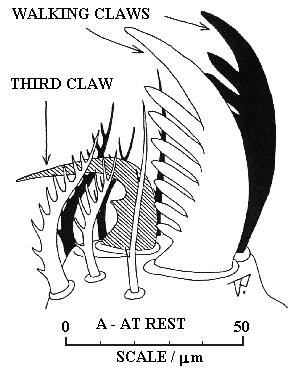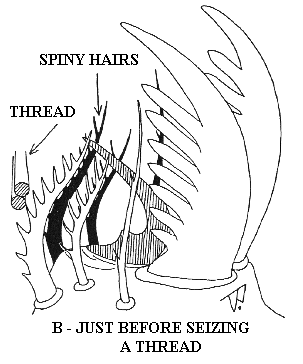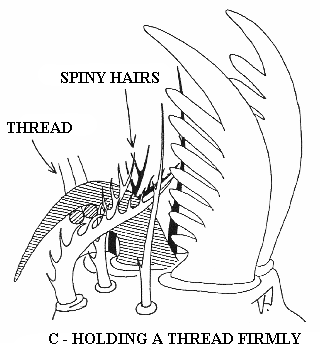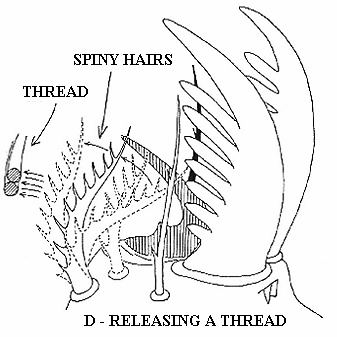Of the many spiders living
in our neighbourhood the garden spider (Araneus diadematus) is one
of the best known. Especially in autumn the large and heavy females catch
the eye, their abdomen swollen with eggs. Hanging head down in the centre
of their magnificent orb webs they are waiting motionless for insects getting
caught by the mass of sticky threads. As soon as that happens, the spider
orients its front into the direction of the disturbance and moves without
hesitation along one of the threads radiating away from the hub, to rapidly
secure its prey .
This action of the spider is not
risky in itself, since all the silk used for making the hub, the radiating
spokes and the strong threads between which the web is hanging, is not
sticky. Only the silk produced to construct the spiral thread connecting
the radii, is covered with a strong glue. Yet, when we observe the spider
walking at high speed along one of the spokes, it regularly touches the
sticky spiral. And once having reached its prey, it does not hesitate to
seize the threads of the sticky spiral with its legs, when approaching
the victim as close as possible in order to immobilise it by wrapping it
in masses of silk and giving it a fatal, venomous bite. Evidently the garden
spider is not afraid of getting stuck in its own web and walks easily along
the non-sticky as well as along the sticky threads. How does it manage
to do so?
To answer this question, we are forced
to catch a garden spider and to investigate the tip of one of its legs
at high magnification. What we see at first glance are the two dark, serrated
walking claws (see figure A). They are used for getting a firm grip on
the relatively smooth surface of the branches and leaves, between which
the spider constructs its web, and for moving over the soil. In front of
them there is a somewhat smaller, strongly hooked third claw, that is surrounded
by a number of bent hairs. The striking difference between these hairs
and the other hairs elsewhere on the spiders legs is not only that they
are conspicuously curved, but also that they are provided of quite a number
of slender spines. These hairs and the third claw play together a crucial
role in the ability of orb spiders (Family Argiopidae) to move around in
their own webs.




We shall trace what happens with
help of figures B, C and D. When the spider places the tip of one of its
legs against a thread (see B) the hooked third claw is tilted backwards,
its pointed end directing obliquely up. The thread, which always consists
of two or more components of at most 0.005 mm across ( 5 micrometres),
is pushed against the elastic, spiny hairs. Then the third claw rotates
forward (see C), the hook seizes the thread, and forces the thread and
the elastic hairs backwards. The leg is holding the thread now in a firm
grip with only a minimal surface area of the thread in touch with the spines
on the hairs and with the inner margin of the third claw. To loosen the
thread the hook of the third claw is simply lifted and the rebounding elastic
hairs, retaining their original upright position, propel the thread away
from the tip of the leg (see D). In this way even a sticky thread becomes
easily detached.



